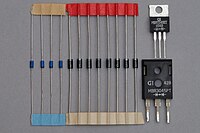
Photo from wikipedia
Au/PVA/n-GaAs (MPS) type Schottky diodes (SDs) were fabricated and investigated in a temperature range of 80–360 K to explain their possible conduction mechanisms (CMs). Three distinct linear regions with different… Click to show full abstract
Au/PVA/n-GaAs (MPS) type Schottky diodes (SDs) were fabricated and investigated in a temperature range of 80–360 K to explain their possible conduction mechanisms (CMs). Three distinct linear regions with different slopes were observed in ln(I)–V plots. The first region (R1), is within the range of 0.22–0.60 V, the second region (R2), is within the range of 0.64–0.90 V, and the third region (R3), is within the range of 1.1–1.5 V. It was shown that both ideality factor (n) and zero-bias barrier height (ΦBo) are strong functions of temperature for all three regions. It was noticed that n values decreased and ΦBo values increased with increasing temperature. In order to ascertain the possible CMs, ΦBo − n, − ΦBo − q/2kT, and (n−1 − 1) − q/2kT plots were also examined. In each of these plots, two linear regions were obtained within each of the three regions. The region from 80–180 K is called the low-temperature range (LTR), and the region from 200–360 K is called the high-temperature range (HTR). It has been revealed that the reason for the deviation from the classical thermionic emission (TE) theory cannot be explained only by the existence of the interface layer, interface states (NSS) or quantum mechanical tunneling mechanisms, which can be also explained by the double Gaussian distribution (DGD) due to barrier inhomogeneity. Finally, the experimental Richardson constants (A*) were calculated from the interception point of the modified Richardson curve in LTR and HTR for all three regions. It was calculated as 6.22 and 8.13 A/cm2K2 for RI, 7.77 and 8.14 A/cm2K2 at R2, and 7.07 and 8.13 A/cm2K2 at R3 for low- and high-temperature ranges, respectively. It is clear that especially HTR results are quite close to the known theoretical A* value of 8.16 A/cm2K2 for n-GaAs.
Journal Title: Journal of Electronic Materials
Year Published: 2020
Link to full text (if available)
Share on Social Media: Sign Up to like & get
recommendations!